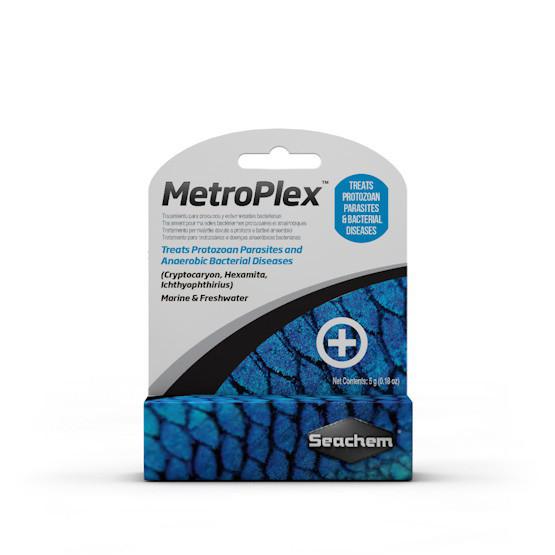Freshnmarine
Seachem Metroplex
Seachem Metroplex
Couldn't load pickup availability
Specifications:
- Treats protozoan parasites and anaerobic bacterial diseases
- Little danger of overdose
- No impact on bio-filter
- Well suited for medicated food mix for internal parasites
Types of Infections Treated
| Parasitic | Fungal | Bacterial | Viral | |
|---|---|---|---|---|
| MetroPlex |
 x x |
 x x |
Directions
Dosing in Water
Remove all invertebrates - these are extremely sensitive to medication. Turn off UV filters, ozone filters, and remove chemical filtration like MatrixCarbon™ and Purigen™. Use 1-2 measures (included) per every 40 L (10 US gallons). Repeat this dose every 48 hours for up to 3 weeks or until symptoms disappear.
Dosing in Food
Feed the medicated food mix (recipe below) every day until the infection clears or up to 3 weeks. This medicated food can be refrigerated or frozen between feedings.
- 1 scoop MetroPlex
- 1 scoop Focus™
- 1 tbsp food (preferably pellets or frozen food)
- A few drops of water if using a dry food
To enhance palatability use with GarlicGuard™ or Entice™.
After Treating
When the treatment period is over, MetroPlex™ can easily be removed using activated filter carbon like MatrixCarbon™. It does not linger in the substrate or filter media of the tank.
Active ingredients: metronidazole (70%)Inactive ingredients: excipients (30%)
Common Fish Diseases Treatable with MetroPlex
Ichthyophthirius (freshwater) / Cryptocaryon (saltwater)
Looks like salt sprinkled on the fish’s body and fins. Usually accompanied by twitching, flashing, and other signs of stress and irritation. Several parasites are grouped under this name, but the symptoms are almost identical. Ich is among the most common infections of fish, and is entirely treatable with diligence and attention to water quality.Suggested Treatment Period:
14-28 daysSpecial Considerations
It is very important with this parasite to continue dosing for the full treatment period. A break in the medication allows the parasite to multiply and reinfect the fish.Piscinoodinium (freshwater) / Amyloodinium (saltwater)
Similar to Ich, but smaller and grey-gold. Most often seen in saltwater, but can occur in freshwater as well. Velvet is less common than Ich, but the treatment is almost identical.Suggested Treatment Period:
14-28 daysSpecial Considerations
Velvet is a photosynthetic parasite - it will help with treatment if you can turn off the lights while the fish are infectedSpironucleus
Symptoms include a loss of color, erosion or lesions on the face, head, and body, and stringy white feces. This condition is often caused by an internal parasite, but factors like poor diet, poor water quality, and lack of trace elements will all contribute to this issue.Suggested Treatment Period:
14 daysSpecial Considerations
In freshwater this condition is called Hole in the Head. Research your fish’s preferred diet and water chemistry to ensure they are being properly duplicated in the aquarium. Consider using a nutrient soak for the food to provide essential vitamins and nutrients to the fish.In saltwater this condition is called Marine Head and Lateral Line Erosion. It can be caused by an internal parasite, but more often these symptoms are connected to nutrient deficiencies or poor water quality. Duplication of the natural environment, proper filtration, and a nutrient-rich diet are all essential to curing this condition in saltwater.
They’re not always on the fish!
Ich, velvet, and many other parasites spend a large portion of their life cycle as a cyst that is immune to medication and hiding in the substrate of your tank. Remember that you need to finish the full treatment even if you can’t see parasites on the fish any more!
Share


